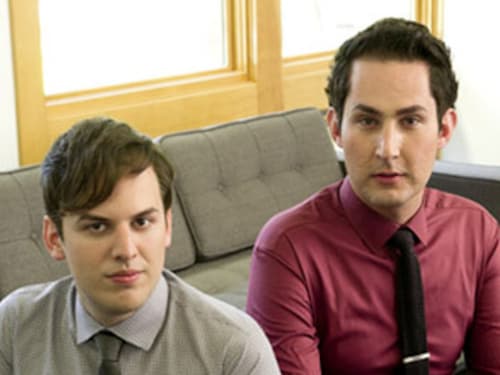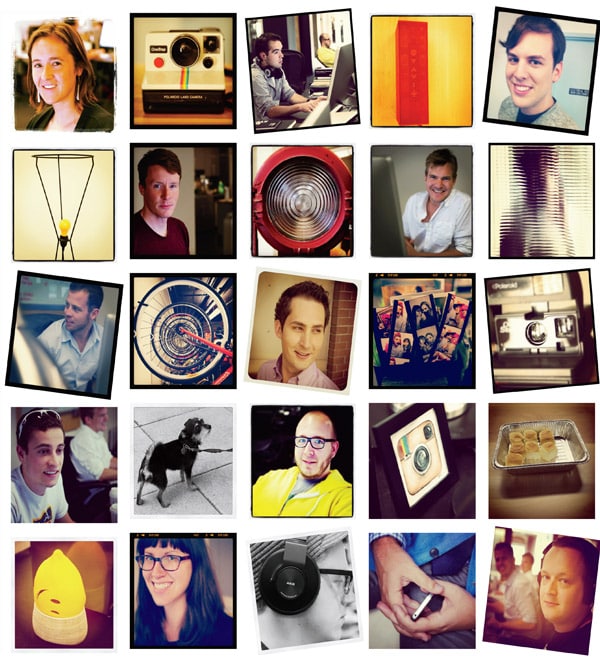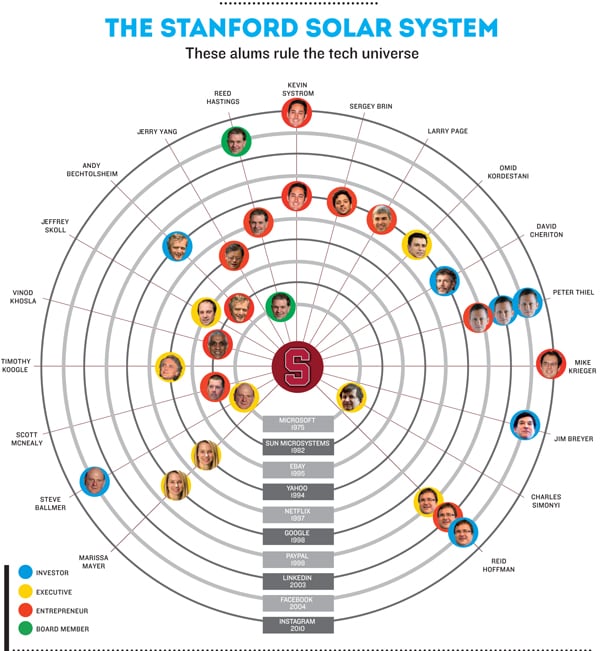How Stanford Made Instagram An Instant Success
Facebook’s $1 billion purchase of the photo app made Kevin Systrom the latest Silicon Valley cult hero. It happened only because he chose school over Zuckerberg’s startup


Kevin Systrom was working a hissing espresso machine at Palo Alto’s Caffé del Doge in the spring of 2006 when Facebook chief Mark Zuckerberg approached the counter with a puzzled look. The previous summer, Zuck had taken Systrom to dinner at Zao Noodle Bar on University Avenue and asked him to ditch his senior year at Stanford to develop a photo service for his nascent social network, The Facebook. Systrom declined. Now, Facebook was worth $500 million—en route to a valuation more than 100 times greater—and making hundreds of headlines. Systrom was making cappuccinos.
“I had been like, ‘No, I don’t want to work at this thing,’ and here I am working at a cafe,’” Systrom, 28, tells me over our $4.50 cups of artisan coffee in the warehouse-like room of Sightglass Coffee in San Francisco’s SoMa district. In opting to stay at Stanford, he turned down what surely would have amounted to tens of millions in Facebook options. “Working at a startup to make a lot of money was never a thing, and that’s why I decided to just finish up school. That was way more important for me,” shrugs Systrom. “I’m sure in retrospect it would have been a nice deal, but it’s funny where you end up.”In Systrom’s case, the place you end up is exactly the place you turned down—Facebook. But thanks to his Stanford detour, instead of eight figures, Systrom, by doing it his own way—developing the white-hot photo network Instagram, which Zuckerberg agreed to buy in April—stands atop a $1 billion score. The purchase price, which makes Systrom’s stake of 40 percent or so worth $400 million, is all the more shocking given that his startup has zero revenues and no revenue model. Instagram, just 22 months old, has all of 14 employees.
But what Systrom also has—and which Facebook, now reeling after a choppy public debut, desperately needs—is buzz, and a mobile platform that has prompted more than 85 million users to share 4 billion photos, with six new members joining every second.
“This is the first thing I’ve seen that feels like it’s truly native to mobile,” says Matt Cohler, former VP, product management, at Facebook and current general partner with Instagram investor Benchmark Capital. “To have scaled the product, the network of users and the infrastructure behind it is nothing short of extraordinary to do it with such a small team is unique in the annals of technology.”
While the Web-based biggies try to jam their products into mobile apps like an overstuffed suitcase into an overhead bin, Instagram’s photo network was jet-set from the start: Fast, stylish and elegant. With a few simple taps you can snap, edit and share an Instagram photo with the world. A few more taps let you do all the things that built Facebook, including comments and likes. “You can look at Facebook as this bundle of many different things, but it turns out that people just like photos more than anything else,” says Adam D’Angelo, former Facebook CTO and current head of question site Quora (as well as an Instagram investor). “So, if you specialise in photos, that’s in some way more powerful than this bundle of everything else.”
Systrom offers yet more proof that in the digital economy a great idea can grow into a billion-dollar company in months. But these windfalls, serendipitous as they seem, are almost never accidental. In Systrom’s case, his good fortune can be traced directly to Stanford.
It was on the Palo Alto campus that Systrom got his first look at the worlds of tech and venture capital, his first internship at a startup and his first job at Google. He discovered his love for vintage photography through a Stanford study-abroad programme and met Zuckerberg and his Facebook crew at a Stanford fraternity party. While searching for a co-founder to launch the company that later morphed into Instagram, it was a Stanford connection that brought the pair together. “When people say that college isn’t worthwhile and paying all this money isn’t worthwhile, I really disagree,” says Systrom. “I think those experiences and those classes that may not seem applicable end up coming back to you time and time again.”
Systrom, a lanky 6-foot-5, loved technology well before college. At 12, he was pranking his friends in Holliston, Massachusetts, over AOL with programs that allowed him to control their cursors or knock them offline. He applied to Stanford to study computer science, but after enrolling in an advanced programming course in his freshman year, Systrom found himself spending 40 hours a week on one class just to squeak out a B: “I loved it but started to think maybe I shouldn’t be a computer scientist.” Instead, he majored in management science and engineering. “It taught me how to be an investment banker.”
Long interested in entrepreneurship and startups (his mom was an early employee of Monster.com and currently works at Zipcar), Systrom spent his free time building websites, such as a Stanford version of Craigslist. Another site, called Photobox, was a place for his fraternity, Sigma Nu, to post photos from the latest keg party.
During junior year, Systrom went to Florence, Italy, to study photography. He arrived with a high-powered SLR camera only to see his teacher swap it for a Holga camera. The cheap plastic device produced quirky square images with soft focus and light distortions that yielded a retro look. Systrom loved the aesthetic. “It taught me the beauty of vintage photography and also the beauty of imperfection.” It was Systrom’s Steve Jobs moment—a flash of artistic inspiration that he would later combine with technology to rocket Instagram ahead of its competitors.
While in Florence, Systrom applied to Stanford’s elite Mayfield Fellows Program: A work-study seminar that threw 12 students into the world of startups and paired them with entrepreneur and VC mentors. “It taught you fundraising, how deals were structured, how they came up with ideas and hired people,” Systrom says. The programme’s co-director, Tina Seelig, says Systrom stood out as an obvious entrepreneur: “He was always building things—always experimenting. It was in his nature to be looking at the world through the lens of ‘Where’s the opportunity here?’”
Through the Mayfield programme Systrom got an internship at Odeo, a podcast company founded by Evan Williams that would later birth Twitter.
Odeo showed Systrom how quick, flexible thinking was vital for survival. During his internship, Systrom created apps with a young engineer, Jack Dorsey, who would start Twitter and the payment company Square. It was a key connection: The two office quickly bonded on runs for deli sandwiches, and Dorsey, now a billionaire, would help Instagram get off the ground, building demand by posting images on his much-followed Twitter account.
Senior year, with help from Stanford career services, Systrom passed on a six-figure project manager role at Microsoft to stay local with a Google marketing gig that paid about $60,000. Google was a recent graduate’s dream—oyster lunches, team-building retreats in Brazil—but Systrom grew bored writing marketing copy for Gmail and Google Calendar. Denied a role in product development (Google required a computer science degree), he switched to corporate development, where he modeled discounted cash flows for companies Google aimed to acquire and saw first hand how big technology deals got done.
Hungry for a startup environment, Systrom jumped to a social travel guide site called Nextstop, where he turned himself into a Valleygrade coder, designing email programs that suggested users to follow, and building Facebook photo games. “All of a sudden, I had a new skill that I could actually put to use,” says Systrom. “When you had an idea, you could actually create it.”
Soon he found something he wanted to create: A site that would combine his passion for photos with location check-ins and social gaming, mimicking the then-surging Foursquare and Zynga, respectively. He chatted up his idea—then known as Burbn, after his favorite booze—at a VC meet-up at the Madrone Art Bar and caught the ear of Baseline Ventures’ Steve Anderson. Anderson says he liked Systrom’s humble confidence and that Systrom’s site would be written in the then “it” code of HTML5. In the winter of 2010, Anderson offered him $250,000 to launch the company (Andreessen Horowitz matched that stake) on one condition—Systrom needed to bring in a co-founder.
Systrom’s Stanford dividends continued long after graduation. He launched Burbn in his one-bedroom San Francisco apartment and would work on the prototype at Coffee Bar in the Mission. There he’d sometimes bump into Mike Krieger, a Brazilian who had graduated from Stanford’s Mayfield programme two years behind Systrom and was working on apps of his own. Krieger had majored in symbolic systems—a Stanford mash-up of technology and psychology that counts LinkedIn’s Reid Hoffman and Yahoo’s Marissa Mayer as alumni—and was working at a chat site, Meebo. On one occasion, Systrom let Krieger download his new check-in app. “I wasn’t superenthusiastic about location-based things, but Burbn was the first one that I loved,” Krieger says.
A month later, Systrom invited Krieger to breakfast to convince him to quit Meebo and join Burbn as co-founder. Krieger’s response: “Count me interested we’ll talk more.” The pair field-tested the partnership—working on small programs—and after a few weeks Systrom proved more convincing than Zuckerberg had been years earlier. Krieger quit Meebo and started what would be a three-month process to obtain a US work visa.
On Krieger’s first day on the job, though, Systrom declared that Burbn wouldn’t survive—Foursquare had too much traction. They had to build something new and decided to streamline Burbn into a photo-only, mobile-focused service. “The iPhone was so new, and people were creating really cool stuff and creating new behaviours,” Systrom says. “It was an opportunity to create a new type of service, a social network that wasn’t based on a computer but the computer in your hand.”
Over two weeks at Dogpatch Labs near AT&T Park, they cranked out a photo app called Codename. Krieger designed the iOS software while Systrom did the code. It was basically an iPhone camera app with social and commenting functions. Neither was too excited about what they had built. Frustrated, Systrom needed a break.
He rented a cheap house at an artist colony in Baja California, Mexico, for a week. While walking down the beach, his girlfriend, Nicole Schuetz, asked how one of their friends posted such amazing-looking photos over the app. His answer? Filters. Suddenly Systrom remembered the cheap camera in Florence. He spent the day in a hammock, researching and designing the first Instagram filter that would become X-Pro II.
Back in San Francisco, new filters followed, like Hefe (named after the Hefeweizen beer Systrom drank while designing it) and Toaster (in honour of the labradoodle owned by Digg founder Kevin Rose). They renamed the product Instagram and gave it to friends—many of them tech influencers like Twitter’s Dorsey—who started posting filtered photos to social networks. Buzz began to build.
Instagram gives low-quality camera phone pics a hip, retro feel. One tap on the touchscreen and an average sunset changes into a tropical postcard, an old bicycle gets a sting of nostalgia and a half-eaten hamburger turns poignant. “Imagine if there was a funny button in Twitter or a clever button in Tumblr,” says Systrom. “Most photo apps before asked something of the users. They said you produce, act and perform. Instagram said let us take care of the secret sauce.”
Recipe in hand, Systrom and Krieger launched Instagram on the Apple app store at midnight on October 6, 2010. Users flowed in, and Systrom and Krieger rushed to keep the servers stable. By 6 am, media sites like Bits Blog and TechCrunch published stories about the debut. The servers melted. Systrom and Krieger worked a straight 24 hours to keep the app running—in that period, 25,000 iPhone users downloaded the free service.
“From that day on we never had the same life,” says Systrom. They called on Quora’s Adam D’Angelo, who Systrom had met with Zuckerberg at a Stanford frat party and who helped Instagram get on Amazon.com servers and scale the platform. After a month, Instagram had a million users. Soon Systrom found himself in the fourth row at Apple’s keynote watching Steve Jobs highlight the app. They had made it to technology’s biggest stage.
As we hang in a booth at a cocktail bar called Tradition—Systrom, Krieger and two early employees, Josh Riedel and Shayne Sweeney—it’s easy to forget that these four twenty-somethings are running a billion-dollar tech company. But when Krieger noticed that a photo he snapped of the bar menu was yet to receive any likes (with 177,000 followers, the response is instantaneous), a MacBook Air, a Verizon Hotspot and a pile of iPhones materialise.
Krieger digs through code as the others text with Instagram engineers via Facebook chat. They find the glitch and get to work. A few minutes later the problem is solved, the gadgets tucked away and another round ordered. “It’s our baby,” says Systrom. “It keeps us up at night and wakes us up in the morning.” Company policy requires engineers to have a laptop at all times. Computers have been whipped out during birthday parties, dates and weddings. Once, Krieger was dining at a farm-to-table restaurant when the system crashed. He roamed the grounds for a wireless connection until he found one bar of service—inside a chicken coop.
These feats of server acrobatics will likely end once the Facebook deal goes through—FTC approval is still pending—and the Instagram team can tap into Zuckerberg’s massive network infrastructure. Systrom says he’s barred from going into detail about the Facebook deal until the regulators approve it. But he did tell me the acquisition happened during a frenzied week in April after he returned from a UK vacation. That Wednesday, Instagram was wired $50 million in a series B round from VCs, including Greylock, Sequoia and Thrive Capital that valued the company at $500 million. On Saturday, Zuckerberg invited Systrom to his Palo Alto home. This time, Systrom accepted. By Monday, the billion-dollar deal—including $300 million in cash—was done.
Facebook’s purchase of Instagram—which has yet to earn a dollar—caused many to scream, “Bubble!” Meanwhile, some insiders whispered, “Bargain!” “It was worth much more than that. I think Facebook got a great deal,” says Quora’s D’Angelo. “It was probably very scary to Facebook that someone else might own Instagram or that it might turn into its own social network. The fact is that everyone is coordinated on sharing photos, and you can’t move them all out onto something else. The network has been built out. It’s too late.”
This kind of buyout often means game over for founders, but with Instagram, Systrom and Krieger are likely in their first quarter. Unlike his other acquisitions, which are quickly absorbed into Facebook, Zuckerberg has publicly pledged to let Systrom run Instagram independently. Systrom and Krieger can use Facebook’s muscle to scale and shape Instagram into a more substantial service. Their goal: Transforming Instagram from a photo app for sharing pics of puppies and pizza into a media company that communicates through photos.
“Imagine the power of surfacing what’s happening in the world through images, and potentially other types of media in the future, to every person who holds a mobile phone,” Systrom says. At its best, Instagram would be a pocket-size window to the world that will deliver a live view of what’s unfolding across the globe—say, Syrian street protests or the Super Bowl sidelines. “I think they have Thomas Edison opportunity,” says Thrive Capital’s Joshua Kushner. “At some point in the next two years, you’ll go onto Instagram and see what’s happening in real time anywhere in the world, and that’s world-changing.”
Before Instagram changes the world, there’s work to be done—an Android-based version launched four months ago—and Systrom admits it’s currently too hard to discover new users, see what’s happening around you, trade comments and look at your photos from the past. He’s also set on creating a website version of Instagram (several clones already exist). And Instagram must continue to expand its user base to a few hundred million before it can truly become the eyes of the world.
Then there’s the revenue thing. Independent or not, Facebook will one day call on Instagram to bring in dollars. Systrom isn’t worrying about that now.
“I think the visual format works with advertisers. If you follow Burberry or Banana Republic you see their Instagram posts are ads, but they’re beautiful,” Systrom says. “Right now, we’re focusing on growth.” Systrom, who lives in the same one-bedroom apartment, relishes a relatively shoe-string life. One night, I head with the gang to the old Army bowling alley in Presidio to celebrate an employee’s birthday. Four Instagramers and I squeeze into Systrom’s black 2002 BMW he bought used when he worked at Google. The GPS is broken, and the $400-million man almost steers us across the Golden Gate Bridge. “I think not focusing on money makes you sane,” he says, “because in the long run it can probably drive you crazy.”
First Published: Sep 04, 2012, 06:32
Subscribe Now
